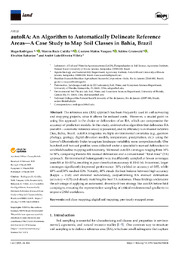AutoRA: an algorithm to automatically delineate reference areas: a case study to map soil classes in Bahia, Brazil.
AutoRA: an algorithm to automatically delineate reference areas: a case study to map soil classes in Bahia, Brazil.
Author(s): RODRIGUES, H.; CEDDIA, M. B.; VASQUES, G. M.; GRUNWALD, S.; BABAEIAN, E.; VILLELA, A. L. O.
Summary: The reference area (RA) approach has been frequently used in soil surveying and mapping projects, since it allows for reduced costs. However, a crucial point in using this approach is the choice or delineation of an RA, which can compromise the accuracy of prediction models. In this study, an innovative algorithm that delineates RA (autoRA—automatic reference areas) is presented, and its efficiency is evaluated in Sátiro Dias, Bahia, Brazil. autoRA integrates multiple environmental covariates (e.g., geomorphology, geology, digital elevation models, temperature, precipitation, etc.) using the Gower’s Dissimilarity Index to capture landscape variability more comprehensively. One hundred and two soil profiles were collected under a specialist’s manual delineation to establish baseline mapping soil taxonomy. We tested autoRA coverages ranging from 10% to 50%, comparing them to RA manual delineation and a conventional “Total Area” (TA) approach. Environmental heterogeneity was insufficiently sampled at lower coverages (autoRA at 10–20%), resulting in poor classification accuracy (0.11–0.14). In contrast, larger coverages significantly improved performance: 30% yielded an accuracy of 0.85, while 40% and 50% reached 0.96. Notably, 40% struck the best balance between high accuracy (kappa = 0.65) and minimal redundancy, outperforming RA manual delineation (accuracy = 0.75) and closely matching the best TA outcomes. These findings underscore the advantage of applying an automated, diversity-driven strategy like autoRA before field campaigns, ensuring the representative sampling of critical environmental gradients to improve DSM workflows.
Publication year: 2025
Types of publication: Journal article
Unit: Embrapa Soils
Observation
Some of Embrapa's publications are published as ePub files. To read them, use or download one of the following free software options to your computer or mobile device. Android: Google Play Books; IOS: iBooks; Windows and Linux: Calibre.
Access other publications
Access the Agricultural Research Database (BDPA) to consult Embrapa's full library collection and records.
Visit Embrapa Bookstore to purchase books and other publications sold by Embrapa.

